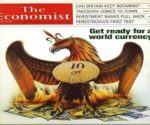“Silent Weapons for Quiet Wars”; Part One: “Inductance” for economic dominance
“Silent Weapons for Quiet Wars” was said to be a top secret “Operations Research Technical Manual” that might have been leaked by being secreted into an IBM copier on its way to a surplus sale. It appeared as the first chapter in “Behold a Pale Horse”, by William Cooper, who explained that the document, dated May 1979, tallied with what had passed across his scope of vision during his time in Naval Intelligence. Cooper told of seeing documents that used the term “Silent Weapons for Quiet Wars” and identified it as the name for “the doctrine adopted by the Policy Committee of the Bilderberg Group during its first known meeting in 1954”. We must bear in mind that [while at Naval Intelligence] Cooper was also fed a lot of nonsense about UFOs and aliens which led him up the garden path for quite the while. Fortunately, he later recognised that he had been a victim of disinformation, and frequently and vehemently stated his opposition to the pedlars of “Ufoology” and presumably, then, the peripheral, but not unsubstantial space-god fantasy, that still serves to minimise and negate the culpability of men, which Cooper himself worked to expose. The fiction of aliens was chiefly to help humanity believe that it could go to the Moon.
Operations Research, as the manual explained in an introductory section, was
A strategic and tactical methodology developed under the military management in England during World War II. The original purpose of Operations Research was to study the strategic and tactical problems of air and land defense with the objective of effective use of limited military resources against foreign enemies (i.e., logistics). It was soon recognized by those in positions of power that the same methods might be useful for totally controlling a society.
FBEL has previously, albeit very briefly, and most importantly quite independently, recognised the reality of military methods for occupying the territory of a vanquished foe being applied to “friendly” populations for the purpose of quelling threats to corrupt and abusive government. Before the author ever came across “Silent Weapons…” he understood observationally that corporate-media was a tool of occupation and suppression. So, “Silent Weapons…” serves as independent verification of something that suggested itself as being self-evident in the manner of British Government. This tells us that the document has worth, even if it doesn’t come from the official source that it is reckoned to emanate from.
The framework for social control as taught in “Silent Weapons…” is a model in which the economy is thought of as an electronic circuit. It’s a tricky concept to master in one or two sittings, and there are gaps in the author’s understanding that are due either to the writer of the document overlooking something that might have been self-evident to him and not explaining it properly, or the author not grasping his own reading fully. However, these are compensated for as best they can be. There is going to be a series of articles (perhaps two) on the work, because it is broader than the impression the reader might have of it by the contents of this paragraph. This article is going to look at the essential elements regarding the concept of electronic-economy. A following article will look at how the system is achieved in real terms through the use of media for creating diversion and confusion, and through the consent of a “docile” public. In the same article, or in a third if there is no room, we’ll be looking at what “Silent Weapons…” teaches us about what can be done to dismantle the system.
There is a power source, and this power source causes capacitors to be charged with voltage. Translating this from electronic to economic terms, this relates to the generation of natural and financial raw material with which to create goods. Hence, the power source represents the people who own the means of production, and it is separate from a consumer horde (which is represented by a separate component that will be addressed shortly). And so, it doesn’t take long when contemplating the economy as an electronic circuit, for one to suddenly understand why we have seen the rise of mega-corporatisation – i.e. the monopolising of industry by a few giant companies. It’s because the system must, by definition, have the holding of capital – or potential – separate to the melee of humanity as a technical requirement for control. The temptation for some people, of course, is to call this the natural outcome of capitalism, but unfortunately for them it has the same hallmarks of the socialist utopia advocated by the likes of H.G. Wells. In the FBEL article on “Rights on Man”, it was noticed that there was an assumption that all people would be employed by government, and the reader is always reminded hereabouts that “government” can come in the form of a body that incorporates big business conglomerates; indeed, socialist “paradise” is explicitly for the purpose of maintaining the dominance of the very people who set it up.
The really important component in the circuit is the inductor. In simple terms, an inductor can be thought of as an iron core with an electricity-conducting wire wrapped around it. When a charge flows through the coil (when there is a current through it), it causes a magnetic field to flow through the iron. This system has an input at the end of the wire, ahead of the coil, from whence the current is motivated, and an output after the coil where the current continues to flow to. This direction of this flow is going to be referred to as the positive direction (whereas the negative direction flows oppositely). What is happening in this system is that charge is being converted into magnetism and stored in that state.
The magnetic field can be manipulated by increasing or decreasing the flow of charge, or current, and it will grow or shrink accordingly. When the current is increased, the system produces an additional charge, which flows in the negative direction. The work against this pushback translates into growth of the magnetic field. When the current is decreased, the magnetic field shrinks, but there is a production of an additional positive charge that mitigates the loss in the magnetic field in terms of output current. Needless to say, when the current remains unchanged into the system, the magnetic field remains the same size. Hopefully the reader can see that an inductor is meant to be for the preservation of electrical energy whereby the output is stabilised against input fluctuations. That is the simple idea to grasp (as far as the author comprehends it).
In the electronics-economics model, the magnetic field produced by the inductor represents population. The action of the charge coming into the inductor is production of goods from raw materials, and the charge itself is their monetary value. The inductor also represents the service industry, which we must understand to be the sale of goods (finance products included) to population. The output is also monetary value, which presumably returns to the power source. To cut to the basic proposition, then, the use of the population to those who control the means of production is the kinetic storage of their energy – or the storage of their wealth through circulation in a population as a guarantee against capital input fluctuations. So, what one realises instantly when exploring this idea is that the people who control the means of production view all wealth as their own, and only on loan to what is essentially a “slave-population” at any time. In fact, let that be rephrased: wealth to the sophisticatedly enslaved, and it might typically look like a mortgage, a car (on Higher Purchase?), two holidays a year, is completely illusory. Real wealth lies in the ability to produce real capital (we’ll return to this in Part Three of this series).
If the technical manual does confuse when drawing comparisons between functioning components of electronics and economics, at least there are abstract treatments of the idea which offer the clearest of explanations. The following, for instance, is one such like, and it get to the real crux of the matter with regards the inductor in the circuit:
In this structure, credit, presented as a pure element called “currency,” has the appearance of capital, but is, in fact, negative capital. Hence, it has the appearance of service, but is, in fact, indebtedness or debt. It is therefore an economic inductance instead of an economic capacitance, and if balanced in no other way, will be balanced by the negation of population (war, genocide)…
War is therefore the balancing of the system by killing the true creditors (the public which we have taught to exchange true value for inflated currency) and falling back on whatever is left of the resources of nature and regeneration of those resources.
If population is to be thought of as magnetic field, then it would follow that it would need to be reduced if there was a failure of input capital (raw material). Just like the magnetic field shrinks when current is reduced, so must the population shrink when input fails in the economic model. The paper “Silent Weapons” talks in terms of war and genocide as measures for the required reduction of population – and we shouldn’t pass over it without commenting on how shocking it is. There is a temptation for normalcy bias to assert itself, and reject the paper as a fiction – and that would be ok if there wasn’t corroboration from other sources. Another alternative to war or genocide that is virtual (and slow) population culling, rather than actual and fast, is outright slavery where people become raw material, and labour for no material gain – and maybe the UK economy is already verging on it. The FBEL reader may remember that there is a recommendation in “The Report from Iron Mountain” for “a sophisticated form of slavery” as a measure for converting from a war system to the socialist World Pax. The recent FBEL article introducing the book didn’t go into this in detail (something is planned for later), but it was a strand that was gathered up with others whereby we could understand where these ideas are coming from. The Bilderberg Group, Cooper tells us, is the Illuminati, which is a word that conjures up a lot of excitement, but merely refers to a state of being illumined a la the Luciferian religion. As it represents a group of anti-human plotters, it appears to be in its history a cabal that infiltrated Masonic lodges to get to the top, and now is a name for those in the highest echelons across many Mystery School secret societies. The Bilderberg Group is something real, where people in the effective corporate-government of the US, UK and Europe meet to steer Globalist policy. The imminent totalitarian Globalist Government, for which there are plans scattered all around for all to peruse if they only took the time, could well become a reality if it can’t be stopped. These real things aren’t coincidental.
The second article in this series can be found here.


















